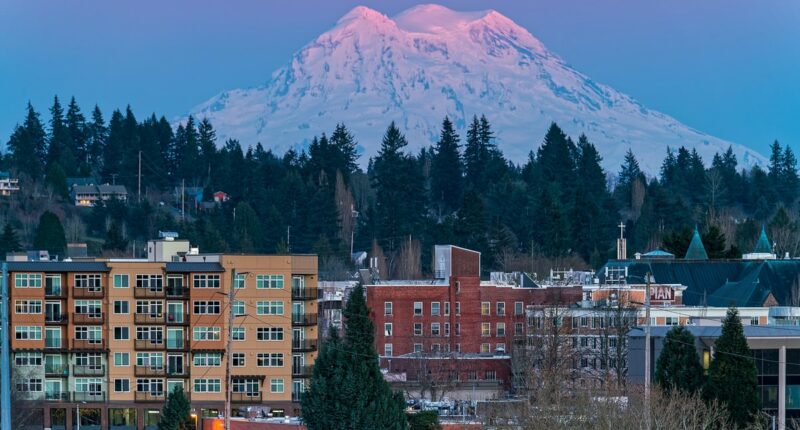Share this @internewscast.com
Hundreds of small earthquakes rattled Washington’s Mount Rainier Tuesday, setting off new fears that one of the most dangerous volcanos in the US could be waking up.
The US Geological Survey (USGS) revealed in a post on X that the earthquake swarm kicked off at 4:29am ET, with none of the tremors surpassing 1.7 in magnitude.
All of the tiny earthquakes took place between 1.2 and 3.7 miles below Mount Rainier’s summit, a generally shallow depth for a quake.
A map released by USGS Tuesday revealed that the new swarm adds to the hundreds, and possibly thousands, of earthquakes recorded at Mount Rainier since 2020.
However, USGS did note that this was the largest swarm in the area since 2009.
Despite the increased seismic activity, officials said that there was no cause for alarm. The volcano’s alert level was left at ‘normal’ following the tremors.
The USGS Cascades Volcano Observatory (CVO) added: ‘Instruments do not show any detectable ground deformation at the volcano, and no anomalous signals have been seen on the infrasound monitoring stations.’
Although an eruption doesn’t seem imminent, Mount Rainier remains one of the most active volcanos in the Pacific Northwest’s Cascade Range, and a devastating eruption remains a real possibility in the near future.

Mount Rainier, one of the most dangerous volcanos in the US, looms over Olympia, Washington. This city is home to more than 50,000 people
Experts consider it to have a very high threat during an eruption due to its volcanic mudflows known as lahars, ash fall, and pyroclastic flows.
Experts say it is only a matter of time until Mount Rainier unleashes itself upon the Pacific Northwest.
This huge, active stratovolcano looms over nearly 90,000 people living in cities such as Seattle, Tacoma, and Yakima in Washington as well as Portland, Oregon.
Even though Mount Rainier has not produced a significant eruption in more than 1,000 years, experts keep a very close eye on it due to its potential to blow at any time, and the widespread destruction such an event would cause.
Jess Phoenix, a volcanologist and ambassador for the Union of Concerned Scientists previously told CNN: ‘Mount Rainier keeps me up at night because it poses such a great threat to the surrounding communities.’
When this volcano eventually blows, it won’t be lava flows or choking clouds of ash that threaten surrounding cities, but the lahars: violent, fast-moving mudflows that can tear across entire communities in a matter of minutes.
Large lahars can crush, abrade, bury, or carry away almost anything in their paths, according to the US Geological Survey (USGS).
‘Tacoma and South Seattle are built on 100-foot-thick ancient mudflows from eruptions of Mount Rainier,’ Phoenix said.

A child floats in muddy water after being caught in the lahar that was triggered by the 1985 eruption of the Nevado del Ruiz volcano in Columbia
This is a strong indication that these populous cities lie within the path of potential lahars generated by a future eruption.
Volcanic eruptions usually cause lahars by rapidly melting snow and ice that covers the volcano’s slopes, which then destabilizes loose dirt, rock and volcanic debris and causes it to flow rapidly downward.
But it doesn’t always take an eruption to trigger a lahar, according to the Seismological Society of America.
Rarely, these powerful mudslides can form as the result of gradual weakening of the volcano’s slopes due to past eruptions, or heavy rainfall after an eruption.
The deadliest lahar in recent history resulted from a 1985 eruption of the Nevado del Ruiz stratovolcano in Tolima, Columbia.
Within hours of the eruption, a torrent of mud, melted snow and rock inundated the town of Armero and killed an estimated 25,000 people.
This event, now known as the Armero tragedy, was the costliest volcanic disaster in history, according to The International Disaster Database. The total economic impact was estimated at $1 billion.
The 1980 eruption of Mount Saint Helens, located in Washington just 50 miles from Mount Rainier, also produced a dangerous lahar that destroyed more than 200 homes, over 185 miles of roads and contributed to the total death toll of 57 people.
These tragic events have helped scientists better understand the threat that lahars pose to human communities around active volcanoes, and experts are currently preparing for the terrifying possibility of a lahar forming at Mount Rainier.

A village on Indonesia’s Java Island was inundated by a lahar after the Semeru volcano erupted in 2022

The 1980 eruption of Washington’s Mount Saint Helens also produced a dangerous lahar that destroyed more than 200 homes, over 185 miles of roads and contributed to the total death toll of 57 people
Over the last 20 years, scientists have been upgrading and expanding lahar monitoring stations around this volcano, collectively known as The Mount Rainier Lahar Detection System.
This system is made up of seismometers and other instruments placed on the volcano’s slopes and vulnerable lahar paths such as the Puyallup and Tahoma Creek drainages.
When this system was first established in 1998, its monitoring capabilities were limited by 1990s-era technology, resulting in significant delays between when a lahar was triggered and when the instruments actually detected it.
However, the new technologies implemented in the last two decades have significantly improved the effectiveness of the system, allowing it to operate in real-time.
Cities near Mount Rainier are also honing emergency response strategies to prepare for a potential eruption.
For example, on March 21, 2024, more than 45,000 students in communities south of Seattle and west of Mount Rainier participated in the world’s largest lahar evacuation drill, according to the USGS.
These measures will help the Pacific Northwest respond quickly and effectively when this volcano erupts, which experts say could happen at virtually any time.








